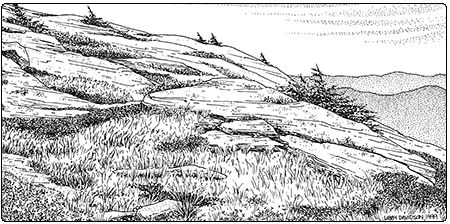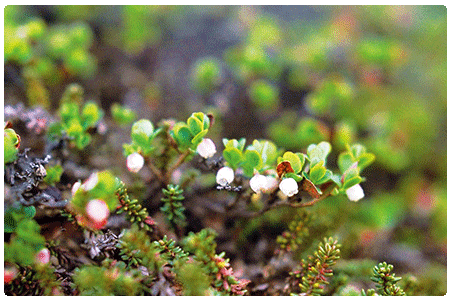Ecology and Physical Setting
Climb to the top of one of Vermont’s tallest mountains—Camel’s Hump or Mount Mansfield—and you’ll find yourself in a world of rock, wind, fog, bonsai trees, and cushion plants. These summits are more reminiscent of the arctic north than they are of the forests below.
Alpine Meadows are open, exposed ridgetops above 3,500 feet where precipitation is abundant, temperatures are low, high winds are common, fog is frequent, and solar radiation can be intense. The thin and mostly organic soils are restricted to low pockets in the otherwise exposed bedrock. In some areas, the bedrock breaks down into small, gravel-like fragments through freezing and thawing, and soil can begin to accumulate in these places.

The climate poses special challenges to vegetation in Alpine Meadows. Wind-driven ice particles damage plant tissues. Snow loading breaks branches. Even in the absence of snow, rime ice forms on plants as supercooled clouds sweep over mountaintops. The weight of this ice as it falls brings leaves and twigs with it. Very low temperatures cause ice crystals to form inside plants as well, damaging cell membranes and dehydrating the cells. In the summer, intense sun causes plants to dry out. Furthermore, the short growing season means that plants have little time to photosynthesize.
Vegetation
All these stresses are apparent in the structure of the vegetation. Trees are rare. Shrubs and herbs are typically very low, and some species assume a “cushion” growth form, with leaves and branches packed tightly together to minimize wind and ice damage. Other plant adaptations include thick, waxy, evergreen leaves, and chemical regulation to protect tissue from freezing and from sun damage.
The variability apparent in Alpine Meadow vegetation reflects variability in environmental stresses, as well as in soil depth and moisture. In areas of the Northeast where Alpine Meadow is more extensive, scientists have recognized several variants of the community. Sedge-dominated meadows are typically interspersed with low shrub communities and areas of lichen-covered bedrock. Scrubby trees grow in the most protected places, where winds are less intense and deep snow protects trees from freezing. Where windblown snow is deposited to great depths on leeward slopes, the late-melting snow shortens the growing season but protects low herbs and shrubs from desiccation. The result is a mixture of alpine and lowland plants.
Although many of the species found in Alpine Meadows are rare in Vermont, they can be found commonly in lowland tundra, a similar community, hundreds of miles to our north. Many common Vermont species can be found in Alpine Meadows, too. These include bunchberry, goldthread, and Canada mayflower.
Wildlife Habitat
These stark, treeless, windblown mountain summits provide little cover for birds and mammals. White-throated sparrows may nest on the fringes of Alpine Meadows near the surrounding stunted balsam fir or spruce forests. Other birds that nest in the montane forests, such as Bicknell’s thrush and blackpoll warbler, may often be seen in Alpine Meadows. Ravens pass overhead and their raucous calls or the sound of air rushing over their wings tell of their approach and passing. Two rare insects—boreal long-lipped tiger beetle and yellow-banded bumble bee—have both been observed in Alpine Meadows. Many other more common invertebrates have also been observed in this community.
Related Communities
- Subalpine Krummholz occurs immediately below, or in sheltered areas surrounded by, Alpine Meadow. It also occurs on some mountain summits that are not high enough to have Alpine Meadows. In Subalpine Krummholz, black spruce and balsam fir form a stunted, dense canopy.
- Boreal Outcrop is very similar to Alpine Meadow and shares many species in common with it, but it occurs at lower elevations, has less severe climatic conditions, and lacks most of the specialized alpine flora.
- Alpine Peatland is a wetland that occurs in depressions within the Alpine Meadow where water accumulates. Sphagnum moss and heath family shrubs dominate.
Conservation Status and Management Considerations
Alpine Meadows are one of Vermont’s rarest and most vulnerable natural communities. Nearly all areas of Alpine Meadow have shallow soils, and both Camel’s Hump and Mount Mansfield have suffered vegetation and soil loss from visitor trampling. Mount Mansfield has also seen dramatic and permanent alteration from buildings, roads, and communication towers. The summits remain vulnerable to heavy visitation and development of infrastructure. Each summer, Green Mountain Club summit stewards vigilantly educate hikers about the fragility of the alpine habitat.
Recent studies of northeastern mountains indicate that trees are increasing their abundance in alpine communities (Capers and Stone 2011, Beal 2009), and herbaceous plants are replacing bryophytes and lichens in the Adirondacks (Robinson et al. 2010). Alpine Meadows are likely to change, possibly dramatically, with expected warmer temperatures and increased precipitation. This community may completely disappear in Vermont because of climate change. Land managers will face tough decisions as they see populations of rare plants decline, and even the local extirpation of alpine species. In some cases, it may be difficult to discern whether the cause is climate change. Should we intervene, and if so, when? There is probably no completely satisfactory answer to this question, but it indicates the choices to come.
Distribution/Abundance
Alpine Meadows are extremely rare in Vermont, occurring only on the summits of Mount Mansfield and Camel’s Hump. Alpine Meadows are also found in New York’s Adirondack Mountains, the White Mountains of New Hampshire, and the higher mountain ranges of Maine. Similar alpine communities are found atop mountains in Québec, Newfoundland, and the Maritimes, and are of conservation importance throughout the region.
Characteristic Plants
Trees
Balsam fir – Abies balsamea
Black spruce – Picea mariana
Shrubs
Alpine bilberry – Vaccinium uliginosum
Black crowberry – Empetrum nigrum
Northern blueberry – Vaccinium boreale
Labrador tea – Rhododendron groenlandicum
Leatherleaf – Chamaedaphne calyculata
Herbs
Bigelow’s sedge – Carex bigelowii
Hairgrass – Deschampsia flexuosa
Highland rush – Juncus trifidus
Mountain sandwort – Minuartia groenlandica
Three-toothed cinquefoil – Sibbaldia tridentata
Cutler’s goldenrod – Solidago leiocarpa
Boreal bentgrass – Agrostis mertensii
Bunchberry – Cornus canadensis
Canada mayflower – Maianthemum canadense
Three-leaved false Solomon’s seal – Smilacina trifolia
Starflower – Lysimachia borealis
Goldthread – Coptis trifolia
Rare and Uncommon Plants

Alpine Meadows. Here it is growing with black crowberry,
another alpine heath.
Boreal bentgrass – Agrostis mertensii
Blackish sedge – Carex atratiformis
Bigelow’s sedge – Carex bigelowii
Diapensia – Diapensia lapponica
Black crowberry – Empetrum nigrum
Alpine sweet grass – Anthoxanthum monticola
Highland rush – Juncus trifidus
Appalachian firmoss – Huperzia appressa
Mountain sandwort – Minuartia groenlandica
Fernald’s bluegrass – Poa laxa
Boott’s rattlesnake-root – Nabalus boottii
Bearberry willow – Salix uva-ursi
Alpine bilberry – Vaccinium uliginosum
Mountain cranberry – Vaccinium vitis-idaea
Cutler’s goldenrod – Solidago leiocarpa
Alpine bistort – Bistorta vivipara
Northern pale painted cup – Castilleja septentrionalis
Northern comandra – Geocaulon lividum
Felwort – Gentianella amarella
Appalachian firmoss – Huperzia appressa
Inland bluegrass – Poa interior
Rand’s mountain goldenrod – Solidago randii
Northern blueberry – Vaccinium boreale
Dwarf bilberry – Vaccinium caespitosum
Liverwort – Gymnocolea inflata
Liverwort – Barbilolophozia sudetica
Liverwort – Mylia taylorii
Moss – Pogonatum dentatum
Moss – Tetraplodon angustatus
Moss – Tetraplodon mnioides
Associated Animals
Snowshoe hare – Lepus americanus
White-throated sparrow – Zonotrichia albicollis
Rare and Uncommon Animals
Bicknell’s thrush – Catharus bicknelli
Boreal long-lipped tiger beetle – Cicindela longilabris
Yellow-banded bumble bee – Bombus terricola
Places to Visit
Mount Mansfield, Stowe, and Underhill, University of Vermont and Vermont Department of Forests, Parks, and Recreation (VDFPR)
Camel’s Hump, Duxbury, Camel’s Hump State Park, VDFPR
